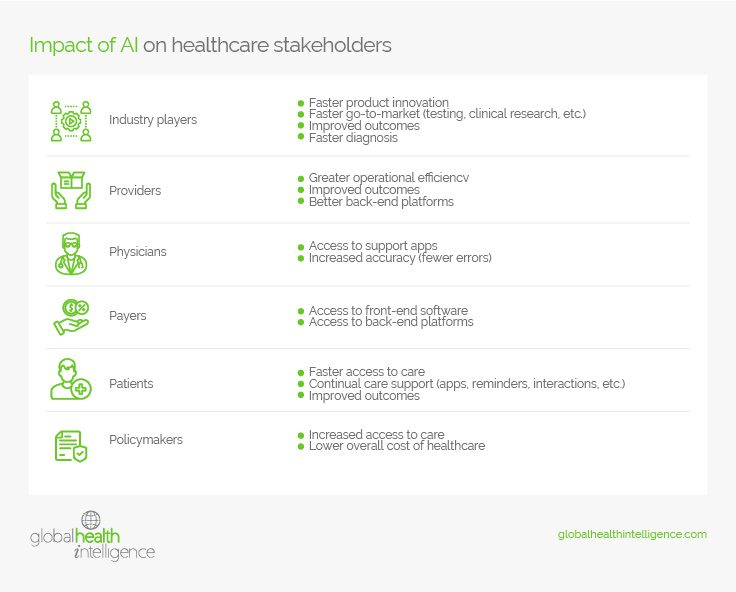Four Major Factors That Will Shape Healthcare in 2024
By Guillaume Corpart
We have analyzed the possible changes that could transform the global healthcare landscape in 2024. As a result, we now have a better understanding of the current economic conditions in Latin America. Let’s examine the factors that will continue to drive change in the healthcare industry this year.
1. Artificial Intelligence
With the public release of ChatGPT in mid-2023, artificial intelligence (AI) grabbed the headlines and hasn’t let up since. In reality, the impact of AI has thus far been largely underwhelming, with most businesses struggling to understand where and how AI will play a role in their sector. On the other hand, the healthcare sector appears poised to be a significant driver in AI as a field at the forefront of disruptive change.
On the innovation side of the spectrum, AI-enabled research has the potential to accelerate discoveries and testing, increasing the speed at which products get to market. Pharmaceutical manufacturers, medical device corporations, and diagnostics firms are among the largest beneficiaries of innovation-based AI.
Pharma players may see a much-needed rejuvenation of their pipelines as some of their best-selling drugs begin losing their patents. Medical device manufacturers – who often associate themselves more with technology firms than with traditional pharma – may cycle through innovation and design at a faster pace to deliver higher value to their stakeholders. Diagnostics firms, including imaging diagnostics, have the potential to incorporate AI within their systems, resulting in quicker and more accurate analysis of test results.
AI’s most significant contributions to the healthcare sector will be related to pace and access. In both diagnosis and treatment, time is critical to treating health concerns. AI has the potential to accelerate the pace at which the industry operates and increase the well-being of millions of people around the globe.
Simultaneously, AI can potentially increase access to care, thus furthering healthcare equity. Faster diagnostics means greater utilization of resources, which can translate to reduced operating costs. Private sector providers will likely be early adopters of AI within their workflows to make their processes more efficient. Meanwhile, public sector providers will be able to dramatically increase access to care, particularly in emerging markets where ~70% of the population is treated by public funding. From innovation to outcomes to diagnostics and treatments, AI has the potential to shorten the patient journey and deliver tangible improvements to the efficiency and efficacy of healthcare systems around the world.
Generative AI, a sub-specialty of the AI field focused on creating content with human-like results, will have an additional impact on the healthcare sector. Generative AI will play a central role in developing interfaces, including front-office software (CRM, marketing, outreach), back-office software (electronic health records, patient interoperability), and event patient platforms to schedule appointments, set reminders, and the like. The healthcare sector will become increasingly dynamic in the coming years, leading to exciting new products and solutions within an innovation-based AI investment super-cycle.
AI does have some potential drawbacks, of course. As AI requires tremendous data inputs, players in the healthcare field will require massive amounts of real-world data to run their models. De-sensitized patient-level information will become the fuel for these models.
The development and implementation of AI come with other risks, as well. Skewed or inaccurate data can lead to harmful or potentially fatal results. On a less extreme scale, AI could also potentially reinforce gender, racial, and other biases. The production of incorrect materials and falsehoods could harm patients, caregivers, or other healthcare stakeholders, reduce trust in AI itself, and further limit potential developments.
From the technology companies that develop AI to the businesses that integrate AI solutions in their medical products, down to the caregivers, providers, payers, and ultimately patients, AI has the potential to overhaul how the industry operates in the years ahead.

2. Demographics
Few trends are as unstoppable as demographics. This is true in all economic sectors, but its impact is particularly acute in healthcare. The escalating share of household expenditures dedicated to healthcare services poses a growing financial strain on many countries. To reverse this trend, it becomes imperative to achieve improved health outcomes with a reduced cost of care. Within the healthcare sector, this entails transitioning from the conventional method of symptom management to addressing root causes. It also requires a shift from disease treatment to preventive measures.
Obesity. The obesity epidemic and an aging population are at the center of the healthcare burden. Latin America continues to experience an increase in the prevalence of obesity in children and adults that exceeds the global average.
The impact of obesity on healthcare systems is well-documented. It’s linked to a wide variety of serious health issues, such as high blood pressure, heart disease, diabetes, and high cholesterol. It’s also responsible for around 2.8 million deaths per year in the region. “In the last 50 years, overweight and obesity rates tripled, affecting 62.5% of the population in the region,” said Dr. Jarbas Barbosa, PAHO Director.
Aging. In Latin America, the percentage of the population age 65 and over grew from 7.0% in 2010 to 9.4% in 2023 and is expected to surpass 10.0% by 2026. This 65+ age group is growing by over 2 million annually and is expected to reach 70 million people by 2026. On average, healthcare costs associated with a person over 65 are three times greater than spending for persons under 65. Considering that, you can see what a critical demographic factor aging can be.
Adjusting to changing demographics. Public healthcare systems treat nearly 70% of the population in Latin America and represent the most significant opportunity to increase efficiency to service demand. However, we expect government stakeholders to maintain a reactionary stance on healthcare as they continue to view systems as a cost rather than an investment in economic productivity and workforce wellness. As long as this is the case, only limited incremental changes driven by individual initiatives will be seen. What is needed are transformative changes that adopt a long-term view of healthcare.
In parallel, we anticipate growing demand for private sector solutions, where most service-based innovations will occur. While a majority of the demand will come from domestic needs, certain countries such as Mexico, Costa Rica, and Panama are well prepared to cater to international demand, particularly from the United States, where healthcare costs continue to soar with only marginal improvements in outcomes.
Gains in operational efficiencies:
- Increase in ambulatory and short-stay surgeries
- Reduction of patient stays within hospitals
- Interoperability
- Homecare
Innovative leadership
- Robotic surgery systems
- Adoption of international best practices
3. G2 tensions
Tensions between the world’s two economic powerhouses (the United States and China) continue to intensify, with technology and, more recently, AI as centerpieces for concern. This has resulted in a reverse flood of onshoring jobs for the United States and initiated a wave of nearshoring opportunities across Latin America.
Uneasiness over China’s policies and regulations toward foreign companies are among critical concerns for foreign businesses in the country. The nearshoring trend is expected to continue as tensions have chipped away at the confidence of U.S. businesses operating in China.
Mexico has been the biggest beneficiary of nearshoring, with exports to the United States growing steadily since early 2022. Costa Rica is another country benefiting from this trend, with its strong export manufacturing base and pro-business culture. In addition to being FDI magnets, Mexico and Costa Rica have strong healthcare sector manufacturing expertise. Meanwhile, manufacturing in China appears to have continuous and sustained appeal for companies looking to gain access to the Chinese market (more so than as a global production base).
4. Armed conflicts and social unrest
Lastly, in light of the ongoing war in Ukraine, the start of the Israeli war in October 2023, and other armed conflicts worldwide, nearly 40% of business executives consider geopolitical tensions a primary concern going into 2024. These concerns rank even higher than common economic issues such as interest rates, the risks of recession, and inflation.
While armed conflicts cause terrible humanitarian and health crises in their regions, history demonstrates a limited spillover effect for the global healthcare sector. National politics and the domestic economy more closely influence the medical sector and healthcare economics.
Of more significant concern in Latin America is the rise of authoritarianism. The continuous and systematic deterioration of democracy across Latin America over the past decade has created the potential for heightened social unrest moving forward. “Democracy in several countries is in critical condition, while others no longer have democracy,” reports Latinobarómetro in their 2023 annual report.
While democracy still stands as the preferred form of government in Latin America, the region shows increased enthusiasm for authoritarian governments and, perhaps more concerning, apathy toward their political leaders. It is alarming to see a deterioration in the support for democracy in countries such as Chile, Mexico, and Costa Rica. Substantial shifts in political ideals will likely result in heightened social tensions and unrest in 2024 and 2025.
Next Steps
Contact GHI to learn about more emerging trends in healthcare and how your sales and marketing team can plan ahead and uncover opportunities within Latin America’s medical device and equipment sector.





